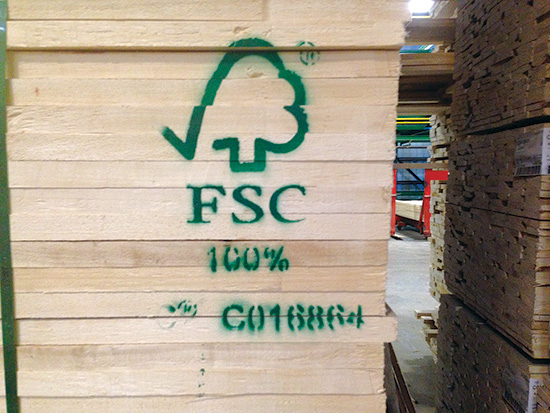Mastering FSC-Certified Wood in Green Building
Beyond LEED
Of course, FSC is recognized well beyond LEED. All credible green building programs acknowledge and incorporate FSC, including model green building codes as well as other voluntary standards. The Living Building Challenge, for example, requires FSC certification as an imperative for all virgin wood used in the building construction.
Regional green building programs that focus on residential construction provide additional market incentives for FSC-certified products. Examples include California’s Build It Green, Earth Advantage (based in Portland, Ore.), the Seattle area’s Built Green program, the Chicago Green Home Program, and Minnesota Green Star. Additionally, many major companies have policies that state a strong preference for FSC-certified products, including The Home Depot, Office Depot, Kimberly-Clark and HP.
Increasingly, end-users and consumers are also requesting FSC-certified products in retail stores across the country.
Research shows that FSC-certified wood products are among the most-specified green building products in the world, according to McGraw Hill Construction. That’s a lion’s share of green building, which in 2012 was estimated at 25 percent of all commercial and institutional building and 20 percent of residential construction, according to McGraw Hill Construction.
Recent examples of projects that showcase FSC-certified wood include the Bullitt Center, the first heavy-timber office building in Seattle since the early 20th century and the first commercial building in the U.S. to obtain full FSC Project Certification— and going beyond that standard’s requirements in using 100 percent FSC-certified wood. “The Bullitt Center is about doing everything right, from the solar array on the roof to the geothermal wells in the ground,” said Bullitt Foundation CEO Denis Hayes when the building opened last year. “When we looked at the wood, FSC was the only way to go.”
Not far from the Bullitt Center are residential projects by design-build firm Green Hammer, which also only use wood from responsible sources. According to the Portland-based company, the client asked for the homes “to be built only with wood harvested from local or responsibly managed forests, [and] Green Hammer suggested aiming for 100 percent Forest Stewardship Council certified wood.” Home construction typically involves many sources and types of wood, so Green Hammer considers this a major achievement, according to Stephen Aiguier, president.
Building teams can turn to a number of tools and resources in sourcing FSC-certified wood products. These include the FSC Marketplace6 and the U.S. Green Building Council’s Green Building Information Gateway, a web-based tool launched in 2012 “to accelerate market transformation by providing greater transparency and understanding of the green dimensions of the built environment,” known as G-BIG.7
Other tools available include the FSC Certificate Database.8 There is also an FSC U.S. Product Inquiry form,9 which allows building designers and owners to submit a request for specific types and quantities of FSC-certified wood products that is distributed to an extensive list of CoC-certified vendors. At annual and regional green building events, notably Greenbuild, FSC-certified companies are always well represented among exhibitors.
While all of the above-mentioned tools are useful, the top-level strategies for successfully incorporating FSC-certified wood into green building are for building teams to (a) identify manufacturers or FSC-certified products that meet project requirements, (b) contact local distributors early to specify FSC products that are available, and (c) ensure that all key links in the supply chain are FSC CoC certified.10
Forests are critical for people, wildlife and climatic stability. Approximately 32 million acres of natural forest are degraded or cleared each year, an area almost as big as the state of Montana. This deforestation and degradation is one of the greatest threats to biodiversity, jeopardizing as much as half of the earth’s plant and animal species. And lest we forget, the clearing and burning of forests generate a fifth of the world’s greenhouse gas emissions.
But the green building professional truly can help rewrite this story. Through specification and material sourcing decisions, the design and construction community is uniquely positioned as a driver of market transformation in the forest sector—there’s every reason to do your part.

Endnotes
- http://makeitwood.org/about
- Meridian Institute. 2011. “Guidelines for REDD+ Reference Levels: Principles and Recommendations,„ http://www.REDD-OAR.org.
- www.fs.fed.us/ecosystemservices
- Green Building Information Gateway
- This means that under LEED 2009, the products contribute to MRc4, not MRc7, and in LEEDv4 they count as recycled content under the Raw Materials Credit.
- www.marketplace.fsc.org
- www.gbig.org
- www.info.fsc.org
- https://us.fsc.org/product-inquiry-form.231.htm
- https://ic.fsc.org/chain-of-custody-certification.39.htm
Brad Kahn is the communications director for the Forest Stewardship Council U.S. He also leads communications for the Bullitt Center, a certified Living Building in Seattle.
Chris Sullivan is an author and principal of C.C. Sullivan (www.ccsullivan.com), a marketing agency focused on architecture, construction, and building products.
 |
Founded in 1855, Collins has a long history as a family-owned forest products company with more than 309,000 acres of FSC-certified forest lands in CA, OR and PA. Products include softwoods, hardwoods, TruWood Siding, Collins Pacific Albus and Alder, and Collins Pine FreeForm, which is the first FSC, NAF particleboard with a Declare Label. www.CollinsWood.com |








